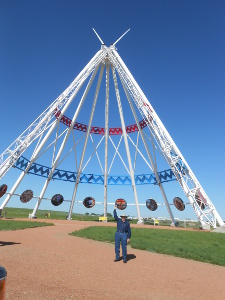 Very high viaduct
as well as wooded river canyons.
Very high viaduct
as well as wooded river canyons.
By the time we reached the Province of Alberta, we had left the Rocky Mountains behind us and had entered land which included farm and ranch land  Very high viaduct
as well as wooded river canyons.
Very high viaduct
as well as wooded river canyons.
In Alberta we learned of different forms of wealth: herds of buffalo, miles and miles of railroad track, rich deposits of pottery clay, and even inherited wealth arrived from England.
In one of the valleys, near Lethbridge, we admired the old railroad viaduct which was constructed in the nineteenth century. It's a sight to behold, even before one considers how difficult it must have been to build.
Our most compelling trip from Lethbridge was to Head Smashed In Buffalo Jump, a UNESCO World Heritage site, one of the places where indigenous people figured out how to kill the buffalo they needed for food, clothing and shelter.
 Travelling schoolroom
Travelling schoolroom
What makes this a world heritage site is that buffalo hunters have been using the cliff for 9,000 years or more. Using the natural topography of small hills with steep drop-offs, the Indians stampeded the herds till they were forced over the cliff. (Of course it took just a year for nineteenth-century non-native hide hunters armed with rifles to destroy the huge buffalo herds and put the Plains Indians out of their traditional business.) The visitors center here is well worth a stop, mostly because of the well-made documentary film which is a good introduction to a walk to the buffalo jump location.
In Stirling we found another in the long sequence of former railroad stations now housing local museums. Here we learned that the LDS Church in Utah made a contract with the Province of Alberta to develop farmland and irrigation in order to attract settlers to this part of the country. We  Tourist pointing at tepee
were the first tourists of the season which gave the pleasant summer students some visitors to practice their tours. We learned about life on the U.S.-Canada border, across from Sweetgrass, Montana. There are stories about rum-running and other kinds of smuggling, and in fact the station was constructed right on the border, with citizens restricted to the side representing their country.
Tourist pointing at tepee
were the first tourists of the season which gave the pleasant summer students some visitors to practice their tours. We learned about life on the U.S.-Canada border, across from Sweetgrass, Montana. There are stories about rum-running and other kinds of smuggling, and in fact the station was constructed right on the border, with citizens restricted to the side representing their country.
We also learned about Lady Angela Burdett-Coutts, the second wealthiest woman in England (after the queen) at the turn of the twentieth century. She was a friend and patroness of Charles Dickens and like him was a passionate reformer, who donated generously to a home, Urania Cottage, for prostitutes who could be reformed. Her husband, William Bartlett, using some of her wealth, invested in the North Western Coal and Navigation Company, Limited, whose first coal mine gave rise to the city of Lethbridge, Alberta, and a town on the U.S. border is named Coutts in her honor. She was the last person to be buried uncremated in Westminster Abbey.
But perhaps the most unusual sight in Stirling was the school car, a railroad coach which traveled through the widely scattered farmland in  Medalta Pottery Works
Alberta. It was the home of the schoolmaster and his family, who traveled through the scattered farmlands of the Province. For a couple of weeks at a time, the car would be stopped at a railroad siding while school was in session. Then, leaving the children with armloads of homework assignments, it would move on to the next place.
Medalta Pottery Works
Alberta. It was the home of the schoolmaster and his family, who traveled through the scattered farmlands of the Province. For a couple of weeks at a time, the car would be stopped at a railroad siding while school was in session. Then, leaving the children with armloads of homework assignments, it would move on to the next place.
The largest tepee in the world -- well, one made out of steel, that is -- is a tourist photograph location in Medicine Hat. See picture.
In Medicine Hat, too, we found the Medalta Pottery Works, which used to make useful containers for businesses and individuals in the area. It failed in the twentieth century, and was even more disabled by a large fire which destroyed part of the plant and some of the machinery. But lately some enterprising young men are re-building it, partly as a working ceramic company, partly as a museum.